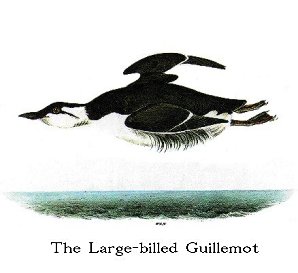
| Family XLIV. ALCINAE. AUKS. GENUS V. URIA, Lath. GUILLEMOT. |
Next >> |

Family |
THE LARGE-BILLED GUILLEMOT. [Thick-billed Murre.] |
| Genus | URIA BRUNNICHII, Sabine. [Uria lomvia.] |
I have never observed this bird on any part of the coast of our Middle
Districts, and, although I was told that it not unfrequently occurred about the
Bay of Boston, I failed in my endeavours to procure it there. The specimen from
which my figure was made was sent to me in ice, along with several other rare
birds, from Eastport in Maine. I received it quite fresh and in excellent
plumage, on the 18th of February, 1833. It had been shot along with several
other individuals of the same species while searching for food in the waters of
Pasmaquody Bay, which were then covered with broken ice. Its flight was
described by Mr. CURTIS, who sent it to me, as similar to that of the Foolish
Guillemot, with which it associated. No other information was transmitted,
excepting that it dived and swam like the other species. I afterwards sent the
skin to my friend the Rev. JOHN BACHMAN, in whose collection it remains.
No individuals of this species were observed by my party on our way to
Labrador; and as the Foolish Guillemot was abundant on the coast of that
country, I concluded that the Thick-billed Guillemots which visit our eastern
seas in winter, set out for the far north at an earlier period than the others.
I am indebted to Mr. HEWITSON of Newcastle, author of the "British Oology," for
a description of an egg of this bird, which is in the valuable collection of the
Messrs. HANCOCKS, who procured it from Greenland. It measures 3 1/8 inches in
length, by 2 1/8 at its broadest part, and is of a bluish-green colour, streaked
and spotted with black or very dark umber.
Male, 18 1/2, 30.
Occasionally procured in Maine. Not very rare off the coast of Nova
Scotia. Breeds from Hudson's Bay to the Arctic Seas.
URIA BRUNNICHII, Bonap. Syn., p. 424.
URIA BRUNNICHII, Brunnich's Guillemot, Swains. and Rich. F. Bor. Amer.,vol. ii. p. 477.
LARGE-BILLED GUILLEMOT, Nutt. Man., vol. ii. p. 529.
LARGE-BILLED GUILLEMOT, Uria Brunnichii, Aud. Orn. Biog., vol. iii. p. 336.
Adult Male in winter.
Bill shorter than the head, stout, tapering, compressed, acute. Upper
mandible with the dorsal line slightly curved, the ridge narrow, broader at the
base, the sides sloping, the edges sharp and inflected, the tip a little
decurved, with a slight notch. Nasal groove broad, feathered; nostrils at its
lower edge, sub-basal, lateral, longitudinal, linear, pervious. Lower mandible
with the angle medial, narrow, the dorsal line sloping upwards and straight, the
back very narrow, the sides nearly flat, the edges sharp and inflected.
Head large, oblong, depressed, narrowed before. Eyes of moderate size.
Neck short and thick. Body stout, rather depressed. Wings small. Feet short,
placed far behind; the greater part of the tibia concealed, its lower portion
bare; tarsus short, stout, compressed, anteriorly sharp, and covered with a
double row of scutella, the sides with angular scales; toes of moderate length,
the first wanting, the third longest, the fourth longer; than the second, all
covered above with numerous scutella, webbed, the lateral ones with small
margins; claws small, slightly arched, compressed, rather acute, that of the
middle toe largest, with a dilated inner edge.
Plumage dense, very soft, blended; on the head very short. Wings rather
short, narrow, acute; primary quills curved, tapering, the second longest, the
first slightly shorter, the rest rapidly graduated; secondaries short, incurved,
broad, rounded. Tail very short, rounded, of twelve narrow feathers.
Bill black. Iris dark brown. Feet dusky, tinged with red. The general
colour of the plumage is greyish-black on the upper parts, those of the head
tinged with brown. The sides of the head and neck, its fore part, the breast,
abdomen, edges of the wings and the tips of the secondaries, white; the sides
shaded with greyish-black; a line of the same behind the eye.
Length to end of tail 18 1/2 inches, to end of claws 21 1/2; extent of
wings 30; wing from flexure 8; tail 2 1/2; bill along the ridge 1 2/12, along
the edge of lower mandible 2; tarsus 1 4/12; middle toe 1 8/12, its claw 5/12.
Weight 2 1/4 lbs.
| Next >> |